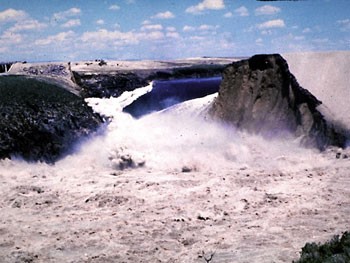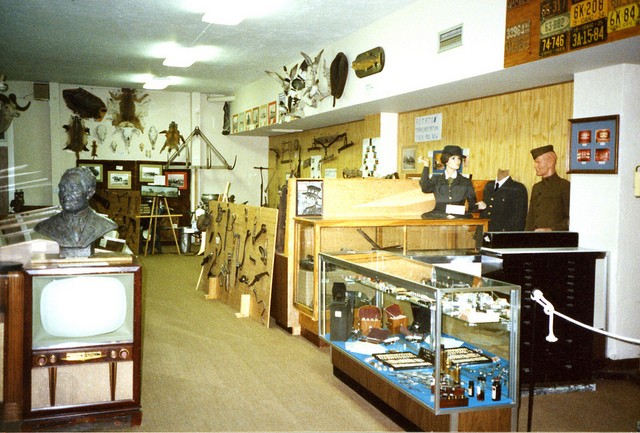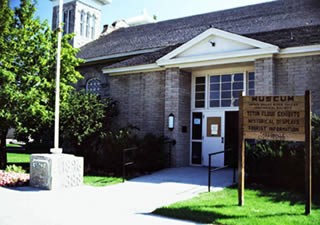Museum of Rexburg
Introduction
Text-to-speech Audio
Known as Teton Flood Museum from 1983 to 2016, this local history museum offers exhibits that drawn from the museum's growing collections of artifacts related to the community's first 125 years. Exhibits focus on Native peoples as well as the first settlers and the equally hardy sours who rebuilt the city after the 1976 devastating flood. The museum also offers an interactive children’s exhibit and a historic one-room schoolhouse. It features the wooden floor and wainscoting from the Japanese Language School, a reading loft, books by Idaho authors, costumes, a small gift shop, and supervised activities and demonstrations. The exhibits have been made possible through grants, donations, and loans.
Images
This is a picture of the Catastrophic failure on June 5, 1976.

This is a picture of the enterance of the museum.

This is a picture of the Teton Dam Flood Museum.

Backstory and Context
Text-to-speech Audio
The museum is located in the basement of the Tabernacle houses the Upper Snake River Valley Historical Society Museum aptly named the Teton Flood Museum because of its extensive collections of flood memorabilia including but not limited to films, photos, and other items related to the Teton Dam disaster. The upstairs of this building is used as a civic auditorium which seats 1000 people and is well known for its excellent acoustics, also there are many pioneer relics, depicting the lives of early pioneers, an Idaho opal/agate collection, North American animal head collection, World War I and II items and much more. History was written in the landscape of the surrounding communities by the scouring floodwaters of the Teton Dam on that fateful day, June 5, 1976, and a lot of the damage has been rectified but there are still tell tale signs of the overwhelming devastation caused by the flood that can never be erased. A high water line marks the entrance to the museum indicating the level of flood water from the 80 billion gallons of water that came through Rexburg. Exhibits have been made possible through many donations, memberships, and other support of the museum. Many one of a kind items are housed here.
On June 5, 1976, a newly constructed earthen dam on the Teton River, in eastern Idaho, catastrophically failed. The dam was built by the US government and was allowed to start filling the previous November, and by June, the lake had reached capacity. At 7:30 in the morning a leak began to appear on the face of the dam. The workers at the site tried to seal the leak with heavy bulldozers during the course of the morning, but the leak steadily grew over the course of the following hours. The workers, realizing the danger, withdrew from the area at the base of the dam.
On June 5, 1976, a newly constructed earthen dam on the Teton River, in eastern Idaho, catastrophically failed. The dam was built by the US government and was allowed to start filling the previous November, and by June, the lake had reached capacity. At 7:30 in the morning a leak began to appear on the face of the dam. The workers at the site tried to seal the leak with heavy bulldozers during the course of the morning, but the leak steadily grew over the course of the following hours. The workers, realizing the danger, withdrew from the area at the base of the dam.
As the flow of water from the northern end of the dam increased, it began to erode the sides of the dam where it was tied to the underlying rock base. At 11:15 AM the authorities warned downstream residents of the impending danger and order evacuation of several towns. Finally at 11:55, just over four hours after the problem started, the top of the dam crumbled and water flowed over the dam in increasing volume. The breach widened, and at the height of the flow over 2 million cubic feet of water poured over the dam every second. By 8 P.M. the lake had been drained and with serious damage to the area with many Idaho homes destroyed.
With this result of this catastrophe, eleven people died, thousands of cattle were lost, there was over $1 billion in property damage, many businesses were lost, and there was a dislocation of several small villages along the river plain. Much of the loss was covered by the US government and payments were made into the 1980’s. The Teton Flood lead to much stricter monitoring of earthen dams in the US, particularly when the federal government is involved. What remains today is a large portion of the dam, showing the breach and the subsequent diggings to examine what went wrong and how it could be avoided in the future. Now the Teton Flood Museum maintains details about the dam’s failure and the aftermath for the residents that live in the area. The museum also houses an auditorium with great acoustics. This is a place to see and enjoy the history of the area.
Sources
http://www.rexburghistoricalsociety.com/teton-flood-museum.html
http://en.wikipedia.org/wiki/Teton_Dam
